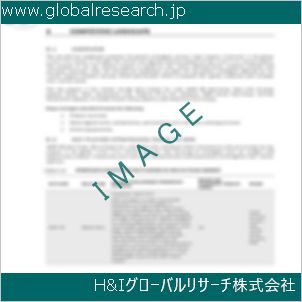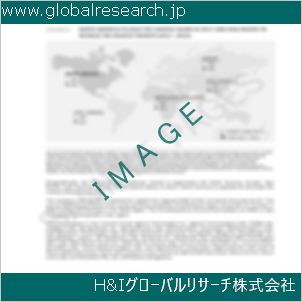1 市場概要
1.1 製品概要と範囲
1.2 市場推定の注意点と基準年
1.3 タイプ別市場分析
1.3.1 概要:グローバル光学濁度センサーの消費価値(タイプ別):2020年対2024年対2031年
1.3.2 ネフェロメトリック濁度センサー
1.3.3 吸収型濁度センサー
1.3.4 散乱および吸収濁度センサー
1.3.5 その他
1.4 用途別市場分析
1.4.1 概要:グローバル光学濁度センサーの用途別消費額:2020年対2024年対2031年
1.4.2 水処理
1.4.3 化学・医薬品
1.4.4 食品・飲料
1.4.5 その他
1.5 グローバル光学濁度センサー市場規模と予測
1.5.1 グローバル光学濁度センサーの消費額(2020年、2024年、2031年)
1.5.2 グローバル光学濁度センサー販売数量(2020年~2031年)
1.5.3 グローバル光学濁度センサーの平均価格(2020年~2031年)
2 メーカープロファイル
2.1 ハッチ
2.1.1 Hachの詳細
2.1.2 Hachの主要事業
2.1.3 Hach 光濁度センサーの製品とサービス
2.1.4 ハッチ 光学濁度センサーの販売数量、平均価格、売上高、粗利益率、市場シェア(2020-2025)
2.1.5 Hach の最近の動向/最新情報
2.2 ターナー・デザインズ
2.2.1 ターナー・デザインズの詳細
2.2.2 ターナー・デザインズの主な事業
2.2.3 ターナー・デザインズの光学式濁度センサー製品およびサービス
2.2.4 ターナー・デザインズの光学式濁度センサーの販売数量、平均価格、収益、粗利益率、市場シェア(2020年~2025年
2.2.5 ターナー・デザインズの最近の動向/最新情報
2.3 Real Tech Inc.
2.3.1 Real Tech Inc. の詳細
2.3.2 Real Tech Inc. の主な事業
2.3.3 Real Tech Inc. 光学式濁度センサー製品およびサービス
2.3.4 Real Tech Inc. 光学式濁度センサーの販売数量、平均価格、収益、粗利益率、市場シェア(2020年~2025年
2.3.5 Real Tech Inc. の最近の動向/更新
2.4 YSI
2.4.1 YSIの概要
2.4.2 YSI 主な事業
2.4.3 YSI 光学濁度センサー製品およびサービス
2.4.4 YSI 光学濁度センサーの販売数量、平均価格、売上高、粗利益率、市場シェア(2020-2025)
2.4.5 YSIの最近の動向/更新
2.5 Fondriest Environmental
2.5.1 Fondriest Environmentalの詳細
2.5.2 Fondriest Environmental 主な事業
2.5.3 Fondriest Environmental 光学濁度センサー製品およびサービス
2.5.4 Fondriest Environmental 光学濁度センサーの販売数量、平均価格、売上高、粗利益率、市場シェア(2020-2025)
2.5.5 Fondriest Environmentalの最近の動向/更新
2.6 イン・シチュ・インク
2.6.1 イン・サイト・インクの詳細
2.6.2 In-Situ Inc. 主な事業
2.6.3 In-Situ Inc. 光学濁度センサー製品およびサービス
2.6.4 In-Situ Inc. 光学濁度センサーの販売数量、平均価格、売上高、粗利益率、市場シェア(2020-2025)
2.6.5 In-Situ Inc. の最近の動向/更新
2.7 ECD
2.7.1 ECDの詳細
2.7.2 ECD 主な事業
2.7.3 ECD 光学濁度センサー製品およびサービス
2.7.4 ECD 光学濁度センサーの販売数量、平均価格、売上高、粗利益率、市場シェア(2020-2025)
2.7.5 ECDの最近の動向/更新
2.8 グローバル水市場
2.8.1 グローバル水市場の詳細
2.8.2 グローバル水市場主要事業
2.8.3 グローバル水光学濁度センサー製品およびサービス
2.8.4 グローバル水光学濁度センサーの販売数量、平均価格、売上高、粗利益率、市場シェア(2020-2025)
2.8.5 グローバル水市場の最新動向/更新情報
2.9 Sensorex
2.9.1 Sensorexの詳細
2.9.2 Sensorexの主要事業
2.9.3 Sensorex 光濁度センサー製品およびサービス
2.9.4 Sensorex 光学濁度センサーの販売数量、平均価格、売上高、粗利益率、市場シェア(2020-2025)
2.9.5 Sensorexの最近の動向/更新
2.10 Sea-Bird Scientific
2.10.1 Sea-Bird Scientificの詳細
2.10.2 Sea-Bird Scientific 主な事業
2.10.3 Sea-Bird Scientific 光学濁度センサー製品およびサービス
2.10.4 Sea-Bird Scientific 光学濁度センサーの販売数量、平均価格、売上高、粗利益率、市場シェア(2020-2025)
2.10.5 Sea-Bird Scientificの最近の動向/更新
3 競争環境:光学濁度センサー(メーカー別)
3.1 グローバル光学濁度センサーの製造業者別販売数量(2020-2025)
3.2 グローバル光学濁度センサーの売上高(メーカー別)(2020-2025)
3.3 グローバル光学濁度センサーの平均価格(メーカー別)(2020-2025)
3.4 市場シェア分析(2024年)
3.4.1 メーカー別光学濁度センサーの出荷量(売上高:$MM)と市場シェア(%):2024
3.4.2 2024年の光学濁度センサーメーカー上位3社の市場シェア
3.4.3 2024年の光学濁度センサーメーカー上位6社の市場シェア
3.5 光濁度センサー市場:全体的な企業足跡分析
3.5.1 光学濁度センサー市場:地域別足跡
3.5.2 光学濁度センサー市場:企業製品タイプ別足跡
3.5.3 光学濁度センサー市場:企業製品用途別足跡
3.6 新規参入企業と市場参入障壁
3.7 合併、買収、合意、および協力関係
4 地域別消費分析
4.1 地域別グローバル光学濁度センサー市場規模
4.1.1 地域別グローバル光学濁度センサー販売数量(2020-2031)
4.1.2 地域別光学濁度センサーの消費額(2020-2031)
4.1.3 地域別グローバル光学濁度センサー平均価格(2020-2031)
4.2 北米 光学濁度センサーの消費額(2020-2031)
4.3 欧州 光学濁度センサーの消費額(2020-2031)
4.4 アジア太平洋地域 光学濁度センサーの消費額(2020-2031)
4.5 南米 光学濁度センサーの消費額(2020-2031)
4.6 中東・アフリカ 光学濁度センサーの消費額(2020-2031)
5 市場セグメント別タイプ
5.1 グローバル光学濁度センサー販売数量(タイプ別)(2020-2031)
5.2 グローバル光学濁度センサーの消費額(タイプ別)(2020-2031)
5.3 グローバル光学濁度センサーの平均価格(タイプ別)(2020-2031)
6 市場セグメント(用途別)
6.1 グローバル光学濁度センサーの出荷数量(用途別)(2020-2031)
6.2 グローバル光学濁度センサーの用途別消費額(2020-2031)
6.3 グローバル光学濁度センサーの平均価格(用途別)(2020-2031)
7 北米
7.1 北米 光学濁度センサーの売上数量(タイプ別)(2020-2031)
7.2 北米 光学濁度センサーの販売数量(用途別)(2020-2031)
7.3 北米 光濁度センサー市場規模(国別)
7.3.1 北米 光学濁度センサーの販売数量(国別)(2020-2031)
7.3.2 北米光学濁度センサーの消費額(国別)(2020-2031)
7.3.3 アメリカ市場規模と予測(2020-2031)
7.3.4 カナダ市場規模と予測(2020-2031)
7.3.5 メキシコ市場規模と予測(2020-2031)
8 ヨーロッパ
8.1 欧州 光学濁度センサーのタイプ別販売数量(2020-2031)
8.2 欧州光学式濁度センサーの売上数量(用途別)(2020-2031)
8.3 欧州光学濁度センサー市場規模(国別)
8.3.1 欧州光学式濁度センサーの販売数量(国別)(2020-2031)
8.3.2 欧州光学式濁度センサーの消費額(国別)(2020-2031)
8.3.3 ドイツ市場規模と予測(2020-2031)
8.3.4 フランス市場規模と予測(2020-2031)
8.3.5 イギリス市場規模と予測(2020-2031)
8.3.6 ロシア市場規模と予測(2020-2031)
8.3.7 イタリア市場規模と予測(2020-2031)
9 アジア太平洋
9.1 アジア太平洋地域 光学濁度センサーの販売数量(タイプ別)(2020-2031)
9.2 アジア太平洋地域 光学濁度センサーの販売数量(用途別)(2020-2031)
9.3 アジア太平洋地域における光学式濁度センサーの市場規模(地域別)
9.3.1 アジア太平洋地域における光学式濁度センサーの販売数量(地域別)(2020-2031)
9.3.2 アジア太平洋地域 光学濁度センサーの地域別消費額(2020-2031)
9.3.3 中国市場規模と予測(2020-2031)
9.3.4 日本市場規模と予測(2020-2031)
9.3.5 韓国市場規模と予測(2020-2031)
9.3.6 インド市場規模と予測(2020-2031)
9.3.7 東南アジア市場規模と予測(2020-2031)
9.3.8 オーストラリア市場規模と予測(2020-2031)
10 南米
10.1 南米 光学濁度センサーの販売数量(種類別)(2020-2031)
10.2 南米 光学濁度センサーの販売数量(用途別)(2020-2031)
10.3 南米光学濁度センサー市場規模(国別)
10.3.1 南米 光学濁度センサーの販売数量(国別)(2020-2031)
10.3.2 南米 光学濁度センサーの消費額(国別)(2020-2031)
10.3.3 ブラジル市場規模と予測(2020-2031)
10.3.4 アルゼンチン市場規模と予測(2020-2031)
11 中東・アフリカ
11.1 中東・アフリカ 光学濁度センサーの売上数量(タイプ別)(2020-2031)
11.2 中東・アフリカ 光学濁度センサーの売上数量(用途別)(2020-2031)
11.3 中東・アフリカ 光学濁度センサー市場規模(国別)
11.3.1 中東・アフリカ地域 光学濁度センサーの販売数量(国別)(2020-2031)
11.3.2 中東・アフリカ地域 光学濁度センサーの消費額(国別)(2020-2031)
11.3.3 トルコ市場規模と予測(2020-2031)
11.3.4 エジプト市場規模と予測(2020-2031)
11.3.5 サウジアラビア市場規模と予測(2020-2031)
11.3.6 南アフリカ市場規模と予測(2020-2031)
12 市場動向
12.1 光学濁度センサー市場ドライバー
12.2 光学濁度センサー市場の制約要因
12.3 光学濁度センサーのトレンド分析
12.4 ポーターの5つの力分析
12.4.1 新規参入の脅威
12.4.2 供給者の交渉力
12.4.3 購入者の交渉力
12.4.4 代替品の脅威
12.4.5 競争の激化
13 原材料と産業チェーン
13.1 光学濁度センサーの原材料と主要メーカー
13.2 光学濁度センサーの製造コストの割合
13.3 光散乱濁度センサーの製造プロセス
13.4 産業バリューチェーン分析
14 流通チャネル別出荷量
14.1 販売チャネル
14.1.1 直接エンドユーザー向け
14.1.2 卸売業者
14.2 光学濁度センサーの典型的な卸売業者
14.3 光学濁度センサーの典型的な顧客
15 研究結果と結論
16 付録
16.1 方法論
16.2 研究プロセスとデータソース
16.3 免責事項
1.1 Product Overview and Scope
1.2 Market Estimation Caveats and Base Year
1.3 Market Analysis by Type
1.3.1 Overview: Global Optical Turbidity Sensors Consumption Value by Type: 2020 Versus 2024 Versus 2031
1.3.2 Nephelometric Turbidity Sensors
1.3.3 Absorbance Turbidity Sensors
1.3.4 Scattering and Absorption Turbidity Sensors
1.3.5 Others
1.4 Market Analysis by Application
1.4.1 Overview: Global Optical Turbidity Sensors Consumption Value by Application: 2020 Versus 2024 Versus 2031
1.4.2 Water Treatment
1.4.3 Chemistry and Pharmaceuticals
1.4.4 Food & Beverage
1.4.5 Others
1.5 Global Optical Turbidity Sensors Market Size & Forecast
1.5.1 Global Optical Turbidity Sensors Consumption Value (2020 & 2024 & 2031)
1.5.2 Global Optical Turbidity Sensors Sales Quantity (2020-2031)
1.5.3 Global Optical Turbidity Sensors Average Price (2020-2031)
2 Manufacturers Profiles
2.1 Hach
2.1.1 Hach Details
2.1.2 Hach Major Business
2.1.3 Hach Optical Turbidity Sensors Product and Services
2.1.4 Hach Optical Turbidity Sensors Sales Quantity, Average Price, Revenue, Gross Margin and Market Share (2020-2025)
2.1.5 Hach Recent Developments/Updates
2.2 Turner Designs
2.2.1 Turner Designs Details
2.2.2 Turner Designs Major Business
2.2.3 Turner Designs Optical Turbidity Sensors Product and Services
2.2.4 Turner Designs Optical Turbidity Sensors Sales Quantity, Average Price, Revenue, Gross Margin and Market Share (2020-2025)
2.2.5 Turner Designs Recent Developments/Updates
2.3 Real Tech Inc.
2.3.1 Real Tech Inc. Details
2.3.2 Real Tech Inc. Major Business
2.3.3 Real Tech Inc. Optical Turbidity Sensors Product and Services
2.3.4 Real Tech Inc. Optical Turbidity Sensors Sales Quantity, Average Price, Revenue, Gross Margin and Market Share (2020-2025)
2.3.5 Real Tech Inc. Recent Developments/Updates
2.4 YSI
2.4.1 YSI Details
2.4.2 YSI Major Business
2.4.3 YSI Optical Turbidity Sensors Product and Services
2.4.4 YSI Optical Turbidity Sensors Sales Quantity, Average Price, Revenue, Gross Margin and Market Share (2020-2025)
2.4.5 YSI Recent Developments/Updates
2.5 Fondriest Environmental
2.5.1 Fondriest Environmental Details
2.5.2 Fondriest Environmental Major Business
2.5.3 Fondriest Environmental Optical Turbidity Sensors Product and Services
2.5.4 Fondriest Environmental Optical Turbidity Sensors Sales Quantity, Average Price, Revenue, Gross Margin and Market Share (2020-2025)
2.5.5 Fondriest Environmental Recent Developments/Updates
2.6 In-Situ Inc.
2.6.1 In-Situ Inc. Details
2.6.2 In-Situ Inc. Major Business
2.6.3 In-Situ Inc. Optical Turbidity Sensors Product and Services
2.6.4 In-Situ Inc. Optical Turbidity Sensors Sales Quantity, Average Price, Revenue, Gross Margin and Market Share (2020-2025)
2.6.5 In-Situ Inc. Recent Developments/Updates
2.7 ECD
2.7.1 ECD Details
2.7.2 ECD Major Business
2.7.3 ECD Optical Turbidity Sensors Product and Services
2.7.4 ECD Optical Turbidity Sensors Sales Quantity, Average Price, Revenue, Gross Margin and Market Share (2020-2025)
2.7.5 ECD Recent Developments/Updates
2.8 Global Water
2.8.1 Global Water Details
2.8.2 Global Water Major Business
2.8.3 Global Water Optical Turbidity Sensors Product and Services
2.8.4 Global Water Optical Turbidity Sensors Sales Quantity, Average Price, Revenue, Gross Margin and Market Share (2020-2025)
2.8.5 Global Water Recent Developments/Updates
2.9 Sensorex
2.9.1 Sensorex Details
2.9.2 Sensorex Major Business
2.9.3 Sensorex Optical Turbidity Sensors Product and Services
2.9.4 Sensorex Optical Turbidity Sensors Sales Quantity, Average Price, Revenue, Gross Margin and Market Share (2020-2025)
2.9.5 Sensorex Recent Developments/Updates
2.10 Sea-Bird Scientific
2.10.1 Sea-Bird Scientific Details
2.10.2 Sea-Bird Scientific Major Business
2.10.3 Sea-Bird Scientific Optical Turbidity Sensors Product and Services
2.10.4 Sea-Bird Scientific Optical Turbidity Sensors Sales Quantity, Average Price, Revenue, Gross Margin and Market Share (2020-2025)
2.10.5 Sea-Bird Scientific Recent Developments/Updates
3 Competitive Environment: Optical Turbidity Sensors by Manufacturer
3.1 Global Optical Turbidity Sensors Sales Quantity by Manufacturer (2020-2025)
3.2 Global Optical Turbidity Sensors Revenue by Manufacturer (2020-2025)
3.3 Global Optical Turbidity Sensors Average Price by Manufacturer (2020-2025)
3.4 Market Share Analysis (2024)
3.4.1 Producer Shipments of Optical Turbidity Sensors by Manufacturer Revenue ($MM) and Market Share (%): 2024
3.4.2 Top 3 Optical Turbidity Sensors Manufacturer Market Share in 2024
3.4.3 Top 6 Optical Turbidity Sensors Manufacturer Market Share in 2024
3.5 Optical Turbidity Sensors Market: Overall Company Footprint Analysis
3.5.1 Optical Turbidity Sensors Market: Region Footprint
3.5.2 Optical Turbidity Sensors Market: Company Product Type Footprint
3.5.3 Optical Turbidity Sensors Market: Company Product Application Footprint
3.6 New Market Entrants and Barriers to Market Entry
3.7 Mergers, Acquisition, Agreements, and Collaborations
4 Consumption Analysis by Region
4.1 Global Optical Turbidity Sensors Market Size by Region
4.1.1 Global Optical Turbidity Sensors Sales Quantity by Region (2020-2031)
4.1.2 Global Optical Turbidity Sensors Consumption Value by Region (2020-2031)
4.1.3 Global Optical Turbidity Sensors Average Price by Region (2020-2031)
4.2 North America Optical Turbidity Sensors Consumption Value (2020-2031)
4.3 Europe Optical Turbidity Sensors Consumption Value (2020-2031)
4.4 Asia-Pacific Optical Turbidity Sensors Consumption Value (2020-2031)
4.5 South America Optical Turbidity Sensors Consumption Value (2020-2031)
4.6 Middle East & Africa Optical Turbidity Sensors Consumption Value (2020-2031)
5 Market Segment by Type
5.1 Global Optical Turbidity Sensors Sales Quantity by Type (2020-2031)
5.2 Global Optical Turbidity Sensors Consumption Value by Type (2020-2031)
5.3 Global Optical Turbidity Sensors Average Price by Type (2020-2031)
6 Market Segment by Application
6.1 Global Optical Turbidity Sensors Sales Quantity by Application (2020-2031)
6.2 Global Optical Turbidity Sensors Consumption Value by Application (2020-2031)
6.3 Global Optical Turbidity Sensors Average Price by Application (2020-2031)
7 North America
7.1 North America Optical Turbidity Sensors Sales Quantity by Type (2020-2031)
7.2 North America Optical Turbidity Sensors Sales Quantity by Application (2020-2031)
7.3 North America Optical Turbidity Sensors Market Size by Country
7.3.1 North America Optical Turbidity Sensors Sales Quantity by Country (2020-2031)
7.3.2 North America Optical Turbidity Sensors Consumption Value by Country (2020-2031)
7.3.3 United States Market Size and Forecast (2020-2031)
7.3.4 Canada Market Size and Forecast (2020-2031)
7.3.5 Mexico Market Size and Forecast (2020-2031)
8 Europe
8.1 Europe Optical Turbidity Sensors Sales Quantity by Type (2020-2031)
8.2 Europe Optical Turbidity Sensors Sales Quantity by Application (2020-2031)
8.3 Europe Optical Turbidity Sensors Market Size by Country
8.3.1 Europe Optical Turbidity Sensors Sales Quantity by Country (2020-2031)
8.3.2 Europe Optical Turbidity Sensors Consumption Value by Country (2020-2031)
8.3.3 Germany Market Size and Forecast (2020-2031)
8.3.4 France Market Size and Forecast (2020-2031)
8.3.5 United Kingdom Market Size and Forecast (2020-2031)
8.3.6 Russia Market Size and Forecast (2020-2031)
8.3.7 Italy Market Size and Forecast (2020-2031)
9 Asia-Pacific
9.1 Asia-Pacific Optical Turbidity Sensors Sales Quantity by Type (2020-2031)
9.2 Asia-Pacific Optical Turbidity Sensors Sales Quantity by Application (2020-2031)
9.3 Asia-Pacific Optical Turbidity Sensors Market Size by Region
9.3.1 Asia-Pacific Optical Turbidity Sensors Sales Quantity by Region (2020-2031)
9.3.2 Asia-Pacific Optical Turbidity Sensors Consumption Value by Region (2020-2031)
9.3.3 China Market Size and Forecast (2020-2031)
9.3.4 Japan Market Size and Forecast (2020-2031)
9.3.5 South Korea Market Size and Forecast (2020-2031)
9.3.6 India Market Size and Forecast (2020-2031)
9.3.7 Southeast Asia Market Size and Forecast (2020-2031)
9.3.8 Australia Market Size and Forecast (2020-2031)
10 South America
10.1 South America Optical Turbidity Sensors Sales Quantity by Type (2020-2031)
10.2 South America Optical Turbidity Sensors Sales Quantity by Application (2020-2031)
10.3 South America Optical Turbidity Sensors Market Size by Country
10.3.1 South America Optical Turbidity Sensors Sales Quantity by Country (2020-2031)
10.3.2 South America Optical Turbidity Sensors Consumption Value by Country (2020-2031)
10.3.3 Brazil Market Size and Forecast (2020-2031)
10.3.4 Argentina Market Size and Forecast (2020-2031)
11 Middle East & Africa
11.1 Middle East & Africa Optical Turbidity Sensors Sales Quantity by Type (2020-2031)
11.2 Middle East & Africa Optical Turbidity Sensors Sales Quantity by Application (2020-2031)
11.3 Middle East & Africa Optical Turbidity Sensors Market Size by Country
11.3.1 Middle East & Africa Optical Turbidity Sensors Sales Quantity by Country (2020-2031)
11.3.2 Middle East & Africa Optical Turbidity Sensors Consumption Value by Country (2020-2031)
11.3.3 Turkey Market Size and Forecast (2020-2031)
11.3.4 Egypt Market Size and Forecast (2020-2031)
11.3.5 Saudi Arabia Market Size and Forecast (2020-2031)
11.3.6 South Africa Market Size and Forecast (2020-2031)
12 Market Dynamics
12.1 Optical Turbidity Sensors Market Drivers
12.2 Optical Turbidity Sensors Market Restraints
12.3 Optical Turbidity Sensors Trends Analysis
12.4 Porters Five Forces Analysis
12.4.1 Threat of New Entrants
12.4.2 Bargaining Power of Suppliers
12.4.3 Bargaining Power of Buyers
12.4.4 Threat of Substitutes
12.4.5 Competitive Rivalry
13 Raw Material and Industry Chain
13.1 Raw Material of Optical Turbidity Sensors and Key Manufacturers
13.2 Manufacturing Costs Percentage of Optical Turbidity Sensors
13.3 Optical Turbidity Sensors Production Process
13.4 Industry Value Chain Analysis
14 Shipments by Distribution Channel
14.1 Sales Channel
14.1.1 Direct to End-User
14.1.2 Distributors
14.2 Optical Turbidity Sensors Typical Distributors
14.3 Optical Turbidity Sensors Typical Customers
15 Research Findings and Conclusion
16 Appendix
16.1 Methodology
16.2 Research Process and Data Source
16.3 Disclaimer
| ※参考情報 光学式濁度センサーは、水中の悬浮物質(SS)の濃度を測定するための装置であり、主に水質監視や環境測定に利用されます。濁度は水中の粒子や物質が光を散乱させる性質を反映しており、その程度を測定することで水の清浄度を評価することが可能です。このセンサーは、さまざまな分野で広く利用されており、その技術や応用について理解することは、環境科学や水質管理の向上にとって重要です。 光学式濁度センサーの基本的な構造は、光源(通常はLEDやレーザー)と光受光部(フォトダイオードやCCDなど)から構成されています。光源から発せられた光が水中の粒子によって散乱し、その散乱光が受光部に到達する際の強度を測定することで濁度を算出します。一般的には、光の波長に応じた散乱光の強度を測定することが多く、特定の波長の光が水中の異なる粒子に対する反応を示すことから、多様な物質を評価することができます。 このセンサーの特徴としては、非接触型であることが挙げられます。水中のサンプルに直接接触することなく、光を通過させることで測定が行えるため、試料の汚染や変質を防ぐことができます。また、リアルタイムでデータを取得できるため、変化を即座に把握することができ、環境監視やプロセス制御において非常に有用です。 光学式濁度センサーにはいくつかの種類があります。まず、透過型と散乱型の2つに大きく分けることができます。透過型は、光が水を通過する際の減衰を測定するタイプであり、光の強度が減少することで濁度を算出します。一方、散乱型は、光源からの光が水中の粒子によってどの程度散乱されるかを測定します。この散乱光の角度や強度から濁度を評価する方法です。 さらに、近年ではデジタル化が進む中で、光学式濁度センサーも高度なデータ処理機能を備えたモデルが増えてきています。これにより、測定誤差の補正やデータのフィルタリング、異常値検出などが行いやすくなっています。また、無線通信機能を搭載したセンサーもあり、リモートモニタリングが可能になることで、より効率的な水質管理が実現しています。 光学式濁度センサーの用途は多岐にわたりますが、主な分野としては飲料水の水質検査、河川や湖沼などの自然水域の監視、工業プロセスでの水管理、そして水処理プラントでの検査などがあります。特に飲料水の分野では、適切な濁度管理が求められ、水質基準をクリアするために欠かせません。また、環境保護の観点からも、河川や湖沼の定期監視は重要な役割を果たします。 光学式濁度センサーに関連する技術として、レーザー光源や高感度の受光機器が挙げられます。これにより、微細な粒子でも精度よく測定できるようになっており、センサー自体の小型化やスマート化にも寄与しています。また、AI(人工知能)を活用したデータ解析技術の導入も進んでおり、ビッグデータやマシンラーニングを用いた水質予測が可能になっています。 さらに、マルチパラメータセンサーとして、濁度以外の水質パラメータ(pH、DO(溶存酸素)、EC(電気伝導度)など)を一括で測定できる機器も登場しており、トータルでの水質評価が行いやすくなっています。これにより、単体の測定値だけでなく、相互関係を考慮した解析ができるようになり、より高度な水質管理が実現しています。 最後に、光学式濁度センサーの今後の展望について考察すると、さらに精度が向上し、低価格化が進むことで普及が進むと考えられます。また、センサーのインターネット化(IoT化)が進むことで、自動化された水質監視システムの実現が期待されます。このようなシステムは、水質のリアルタイムモニタリングを実現し、迅速な対応を可能にし、環境問題の解決に寄与するでしょう。 光学式濁度センサーは、現代の水質管理や環境監視において欠かせないツールであり、その進化は今後も続くことが予想されます。環境に優しい社会の実現に向けて、この技術のさらなる発展と普及が期待されます。 |
❖ 免責事項 ❖
http://www.globalresearch.jp/disclaimer












